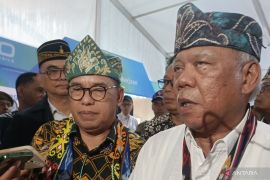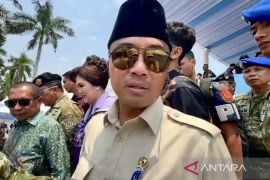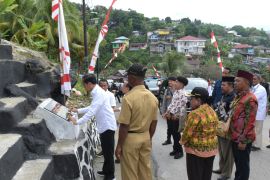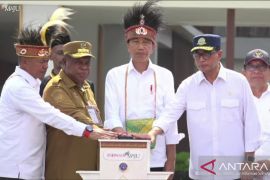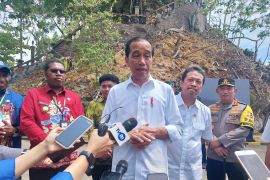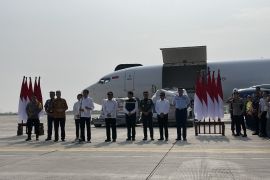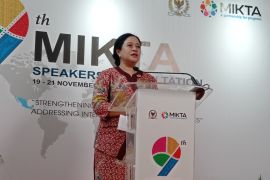With a focus on the Indonesia-centric development concept, the country's development is not solely centralized in Java island, so all communities across the country can reap the results.
Until the president's second term, several toll roads, national roads, dams, ports, and telecommunication tower projects have been built. Moreover, the mega project of moving the capital city from Jakarta to Nusantara in East Kalimantan has been started.
Infrastructure is an important aspect of building connectivity in Indonesia as an archipelagic country. Transportation connectivity between regions and between areas, on land, sea, and air, will boost economic growth and public welfare.
With connectivity, the logistics needs of people in Indonesia's regions will be increasingly met, thereby reducing price gaps between regions. Accelerated trade and services will open up employment opportunities as widely as possible.
Transportation connectivity will also enable regions in Indonesia to be accessible and easily visited, thereby opening up tourism potential that can become a new source of economic growth in each region.
During President Jokowi's two terms of government, national road construction has reached 5,999 km. The roads were built with the goal of improving national connectivity, opening access for isolated areas, reducing disparities between regions, and supporting the national logistics system.
Meanwhile, during the 2015-2024 period, toll road construction reached 2,432 kilometers, spread across the islands of Sumatra, Java, Kalimantan, Sulawesi, and Bali. Thus, the total toll road sections already operational as of 2024 reached 3,212 kilometers.
Furthermore, the construction of flyovers, aimed at increasing safety and reducing traffic congestion, has reached 27,673 meters.
In addition to connectivity infrastructure, under Jokowi’s presidency, the government has made efforts to fulfill people’s rights to drinking water and access to clean water through the development of the Drinking Water Supply System (SPAM).
In the 2015-2024 period, SPAM development in Indonesia increased the water supply by 36,380 liters per second and clean drinking water access to 93 percent in 2024.
The provision of decent housing also received attention. During the two terms of office, Jokowi handled 94,321 hectares of residential areas through a slum handling program, the development of national strategic tourism areas, and revamping of cultural heritage areas.
Under the One Million Houses Program (PSR), a total of 10,207,340 houses have been built.
The government has also renovated educational, sports, and market facilities and infrastructure, with a total of 5,939 units comprising 5,725 units of educational infrastructure, 88 markets, and 126 stadiums/venues.
To accelerate the construction of strategic and urgent infrastructure, the government created a mechanism for the acceleration of infrastructure provision and the issuance of regulations as the legal basis through the National Strategic Project (PSN) program.
In total, 190 PSNs were built under President Jokowi's presidency with a budget of Rp1,656.75 trillion (around US$106.17 billion).
Those projects include 48 road projects, 56 dam and irrigation projects, 27 areal projects, 13 rail projects, 17 energy projects, 15 port projects, nine clean water and sanitation projects, seven airport projects, six technology projects, and other projects such as plantation, education, embankment, and housing projects.
In addition to connectivity projects, Jokowi accelerated the development of supporting infrastructure to increase food and electricity production, reflected by the massive construction of dams and irrigation canals.
Over the past decade, the government has built 53 dams out of a target of 61 dams.
These dams have an accumulated water volume of 3.89 billion cubic meters, so they can irrigate 395,669 hectares of land, retain floodwaters with a capacity of 13,596 cubic meters per second, and also be used to generate 225.15 megawatts of electricity.
Furthermore, the construction of irrigation networks to increase food production reached 1,228,440 hectares, while rehabilitation of existing irrigation networks covered a total area of 4,647,547 hectares.
To date, there are 7.5 million hectares of irrigated land in Indonesia, with the area of rice fields supported by irrigation from dams increasing from 11 percent in 2014 to 19 percent or 1.4 million hectares in 2024. As a result, the cropping index increased from 1.5 in 2014 to 2.5 in 2024.
Massive efforts in water infrastructure programs are also reflected in the development of retention basins for the provision of raw water, flood control, and water reserves, reaching 1,371 retention basins.
In addition, supporting infrastructure in the form of flood control and coastal protection, with a total length of 2,154 kilometers, has also been provided to protect coastal cities experiencing abrasion and erosion.
President Jokowi also instructed the Ministry of Public Works and Public Housing to boost development in the border areas by creating new sources of economic growth.
One of the efforts made is building 15 border posts across the country from 2015 to 2024.
In addition to creating new centers of economic growth, the construction of border posts is aimed at emphasizing and maintaining the boundaries of the country at the outermost points and ensuring the border areas are safe and sovereign outermost regions of the country.
Social infrastructure
The development of several infrastructures from various sectors is recognized to have provided positive impacts to the community. However, other issues that must be addressed are the environmental and social impacts that should also be addressed further.
Thorough development planning, starting from the sustainable development concept, benefits of the project, job creation, and efficient management, is essential to be considered in every infrastructure project.
In line with the infrastructure in various regions, social infrastructure is also needed to improve the community's skills and capacity, quality of life, and productivity, especially in underdeveloped, frontier, and outermost (3T) areas.
That way, the country would not only have advanced infrastructure but also excellent human resources to achieve the Golden Indonesia 2045 vision.
By increasing the community's capacity, development in the future will boost people's welfare. This is because it is driven by the improvement in the community's capability in several economic sectors, making it in line with the Mental Revolution idea campaigned by Jokowi during the 2014 Presidential Election.
The next government is tasked with paying attention and providing concrete solutions that impact all aspects of people's lives, with infrastructure development conducted on a massive scale in the country.
Translator: Sinta Ambarwati, Raka Adji
Editor: Azis Kurmala
Copyright © ANTARA 2024

